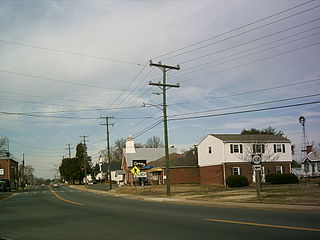
The William H. Trusty House is a historic home located in the Phoebus section of Hampton, Virginia. It was built in 1897, and is a 2 1/2-story, wood frame dwelling in the late Victorian style. It features a two-story, spindle-and-bracket porch, with a tent roof and capped by a finial. It was built by William H. Trusty, a successful black businessman and civic leader. Trusty owned a bar, five houses, and two Main Street Business properties. He was the son of freed parents from Prince George County, Virginia.
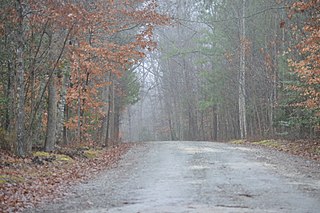
Burlington is a historic plantation house located near Aylett, King William County, Virginia. The main house is a two-part structure consisting of the Classical Revival-style main portion, erected in 1842, and a fragment of a Colonial-period frame dwelling serving as the rear ell. The main section is a two-story, stuccoed brick dwelling with a standing seam metal gable roof. The earlier portion is topped by a hipped roof. Also on the property are the contributing old smokehouse, an early framed barn, and a family cemetery surrounded by a brick wall.

Roseville Plantation, also known as Floyd's, is a historic plantation home located near Aylett, King William County, Virginia. The main house was built in 1807, and is a 2 1/2-story, four bay, frame dwelling in the Federal style. It sits on a brick foundation and is clad in weatherboard. Also on the property are the contributing one-story, one-bay detached frame kitchen; a one-story, two-bay frame school; a large, one-story, single-bay frame granary; a privy, a 1930s era barn, and two chicken houses, of which one has been converted to an equipment shed. The property also includes a slave cemetery and Ryland family cemetery.

Windsor Shades—also known as Ruffin's Ferry and Waterville—is situated on the Pamunkey River about 10 miles up river from West Point in King William County, Virginia. Archeological native artifacts found on the property surrounding the house suggest it was the site of the Kupkipcok, a Pamunkey village noted on John Smith's 1609 map.

Wyoming is a historic home located near Studley in King William County, Virginia. It was built about 1800, and is a two-story, five bay, Georgian style frame dwelling. It has a single-pile, central hall plan and is set on a brick foundation. The house is topped by a clipped gable roof with a standing-seam sheet metal surface and modillion cornice. It measures 55 feet long and 25 feet deep.

Fairfield Farms is a historic estate house located near Berryville, Clarke County, Virginia. It was built in 1768, and designed by architect John Ariss and built for Warner Washington, first cousin to George Washington. During his surveying for Lord Fairfax, George Washington helped survey and layout the property for John Aris. It is a five-part complex with a 2 1⁄2-story hipped-roof central block having walls of irregular native limestone ashlar throughout. It is in the Georgian style. Located on the property are a contributing large brick, frame and stone barn and an overseer's house.

Hillsborough is a historic plantation house located near Walkerton, King and Queen County, Virginia. It was built in the mid-18th century, and is a two-story, five bay, brick and frame dwelling. It has a hipped roof and a frame two-story wing. Also on the property are the contributing small frame smokehouse with pyramidal roof and a one-story brick storehouse.

Farmington is a historic plantation house located near St. Stephens Church, King and Queen County, Virginia. The original structure was built about 1795, and later enlarged and modified to its present form in 1859-1860. It is a large two-story frame house, with a low-pitch hipped roof and deep eaves. It has a two-story rear addition on the building's southwest side and a one-story addition on the southeast side. Also on the property are a contributing large braced-frame barn, a weaving house, and an overseer's house.
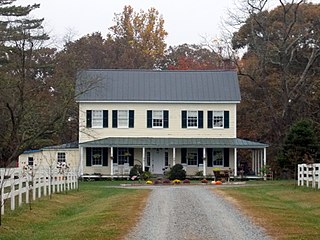
Cleydael, also known as Quarter Neck, is a historic home located near Weedonville, King George County, Virginia. It was built in 1859, and is a two-story, five bay, frame dwelling. It has a standing seam, metal gable roof and wraparound porch. The house served as the summer residence for King George County's wealthiest resident, Dr. Richard H. Stuart.

Eagle's Nest is a historic home located near Ambar, King George County, Virginia. It dates to the mid-19th century, and is a two-story, rectangular, seven-bay house of timber-frame construction. It measures 80 feet long and 36 feet deep and was built in four phases. The house was built on the foundation of an earlier dwelling. Also on the property are the contributing frame, three-bay, single pile, late-18th century dwelling called Indian Town House, moved to the site in 1989; the remains of an old icehouse; and a family cemetery, which holds the graves of several descendants of William Fitzhugh (1651-1701).

Marmion is a historic home located near Comorn, King George County, Virginia. The original section was built about 1670 by William Fitzhugh (1651-1701), progenitor of the Fitzhugh family in Virginia. It took its present form after 1790 or 1800. The house is a frame, two-story house with a clipped gable roof and two interior end chimneys with exposed chimney shafts. Also on the property are the contributing smokehouse, dairy, kitchen, and office.

Rokeby is a historic home located at King George, King George County, Virginia. The original section was built about 1828, and is a two-story, three bay Federal style brick dwelling. It has a low hipped roof, tripartite windows, lintel-type window heads, and elliptical, leaded-glass fanlight with flanking sidelights. The original block was enlarged about 1912 by a pair of flanking two-story, frame pavilions, and in 1917, the west wing was substantially enlarged. Also on the property are the contributing antebellum smokehouse and a complex of buildings built in 1917-1920: (1) schoolhouse; (2) summer / tenant house; (3) playhouse; (4) garage; (5) Sears, Roebuck catalog-ordered horse barn; (6) sheep barn; and (7) cattle run-in shed.

Office Hall is a historic plantation house located at King George Court House, King George County, Virginia. The remaining buildings are a two-story detached kitchen, built about 1805-1820, and a large, pyramidal-roofed smokehouse. Also on the property is a non-contributing, commodious two-story frame farmhouse built about 1916-18, and a number of 20th century farm outbuildings.
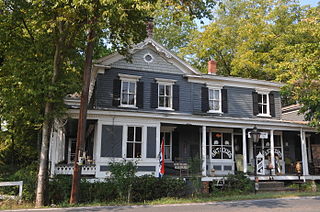
Davis–Beard House, also known as Glee Hall and Davis House, is a historic home located at Bristow, Prince William County, Virginia. It was built after the American Civil War, and is a two-story, five bay, frame I-house dwelling with later additions. The rambling dwelling has a number of Late Victorian style decorative elements. It features a one-story wraparound porch, decorated gables, bay windows, and storefront. Also on the property are a contributing brick hip-roofed carriage house and a small lattice-covered frame privy.

Sperryville Historic District is a national historic district located at Sperryville, Rappahannock County, Virginia. It encompasses 63 contributing buildings in the village of Sperryville. The buildings are predominantly wood-frame, one-and two-story residences. They include a collection of former factory workers' housing built to serve the workers of the Smoot tannery from 1867 to the early 20th century. A number of the buildings were built after 1850 with ornamentation and board-and-batten siding that is suggestive of the mid-century Romantic Revivals. Notable buildings include the George William Cooper House, the Dr. Amiss House, and the Totten's Mill House.

George L. Carder House, also known as Boxwood Hill, is a historic home located at Castleton, Rappahannock County, Virginia. It was built about 1833, and is a two-story, Federal style brick dwelling on a limestone foundation. It features a pair of front entrances and an original kitchen built into the cellar. The property also includes a contributing one-room log house, log shed, and wood-framed barn.
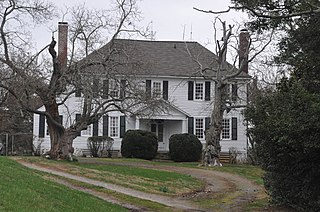
Carlton is a historic home located at Falmouth, Stafford County, Virginia. It was built about 1785, and is a two-story, five bay, Georgian style frame dwelling. It has a hipped roof, interior end chimneys, and a front porch added about 1900. The house measures approximately 48 feet by 26 feet. Also on the property are the contributing frame kitchen partially converted to a garage, frame dairy, and brick meat house.

George Oscar Thompson House, also known as the Sam Ward Bishop House, was a historic home located near Tazewell, Tazewell County, Virginia. It was built in 1886–1887, and was a two-story, three bay, "T"-shaped frame dwelling. It had a foundation of rubble limestone. The front facade featured a one-story porch on the center bay supported by chamfered posts embellished with sawn brackets. Also on the property were a contributing limestone spring house, a one-room log structure, and a 1 1/2-story frame structure. Tradition suggests the latter buildings were the first and second houses built by the Thompson family.

Blenheim is a historic home located near Wakefield Corner, Westmoreland County, Virginia. It was built about 1781, and is a two-story, three bay, Late Georgian style brick dwelling. It has a gable roof and two-story, frame wing. The house was built by the Washington family to replace the original family house at Wakefield soon after it burned on Christmas Day, 1779. The house was built for William Augustine Washington, the son of George Washington's half-brother Augustine Washington II.
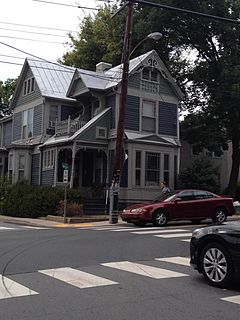
The King–Runkle House is a historic home located at Charlottesville, Virginia. It was built in 1891, and is a two-story, Late Victorian style frame dwelling with a two-story rear wing. It is sheathed in weatherboard and has a steeply pitched gable roof. The house features a simple one-story semi-octagonal bay window, ornamented porches and a projecting pavilion, and Eastlake Movement gable ornamentation.

